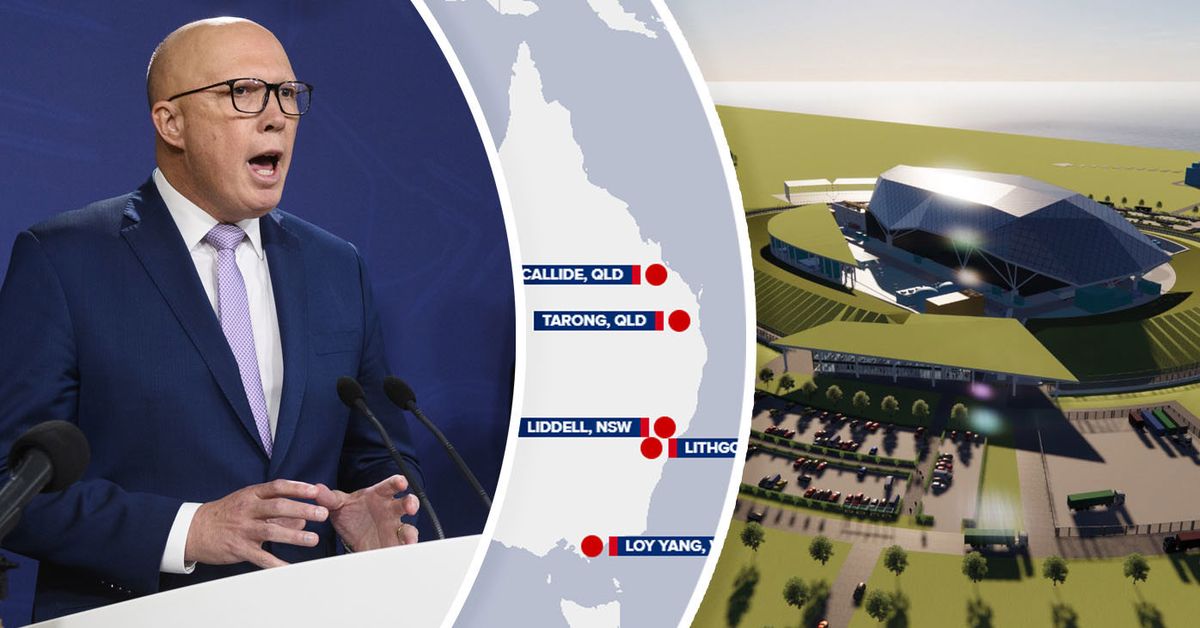[ad_1]
The government criticized the announcement, describing it as a “fantasy” that lacked key details.
Speaking at a press conference this morning, Dutton said the plants would be built on the sites of existing coal-fired power stations: two in each of NSW (Lithgow and Liddell) and Queensland (Tarong and Callide), plus Victoria’s Loy Yang, Western Australia’s Collie and Port Augusta in South Australia.
Would you vote for the coalition at the next election based on the proposed nuclear plan?
Dutton said two plants would be commissioned between 2035 and 2037 – much shorter than some experts thought possible – and said the nuclear plants would be publicly owned.
However, he declined to say how much the plan would cost taxpayers, although he admitted it would be a “big bill.”
“We will have more to say in relation to the costs in due course and, as you know, we have done this in a step-by-step process,” he said.
“The focus today is on sites.
However, the government’s focus was on what it claimed was a lack of detail on energy costs and generation in the announcement.
“(It’s) a no-detail, no-cost putative policy,” Energy Secretary Chris Bowen said.
“If Labor tried this in opposition we would be torn apart – quite rightly so … if (Dutton) can’t share those details then the Australian people have a right to come to the view that he is not serious when it comes to the energy.”
Asked how the coalition would get the power stations up and running in just 10 years after the next election, Dutton said energy plans would rely on overseas experience.
“We want to rely on international experience,” he said.
“We don’t want to be first-in-class buyers or have Australian technology.”
Dutton said all nuclear waste from the plants would be stored on site until transferred to the same storage facility used for waste from AUKUS submarines.
He said all seven power plants will be operational sometime in 2040
The long-awaited announcement was approved at a full meeting of the Coalition’s party room this morning.
Dutton had planned to make the announcement during the parliamentary recess next month, but recent strong poll results for the Coalition prompted him to postpone it.
The Opposition Leader says nuclear power will be needed for Australia to meet its net-zero emissions target by 2050.
But the move has sparked tensions with some Liberal MPs and coalition partners the Nationals, while Labor insists renewable energy is the best source to power Australia’s grid.
National Senator Matt Canavan said Today this morning he would be happy to see nuclear power stations in his home state of Queensland.
“If we want lower electricity prices, we need more reliable power right now is why your electricity bills are going up so much,” Canavan said.
Canavan said the coalition would offer a “balanced energy policy” with renewables as part of it.
NSW and other states have their own nuclear bans through state legislation, which must be lifted for the Coalition’s plan to be implemented.
Dutton said he would negotiate with prime ministers to lift those bans, suggesting they could be persuaded with a “bucket of money”.
But NSW Premier Chris Min said switching to nuclear was too expensive and the form of energy was banned in the state.
“Who pays for this? Will it just go on the federal government debt? That’s a huge amount of money. And the truth is, we don’t have a spare minute,” he said Today.
“We need to shift power generation from coal to another source in a very short period of time.”
[ad_2]
